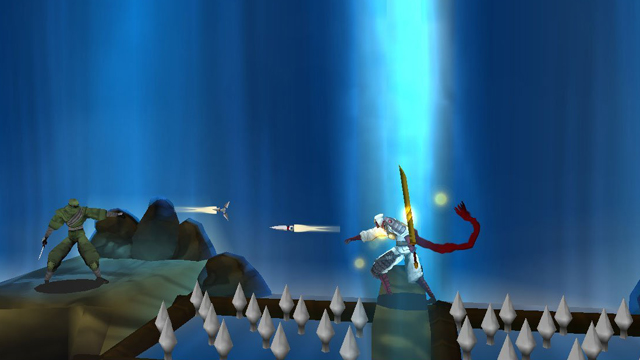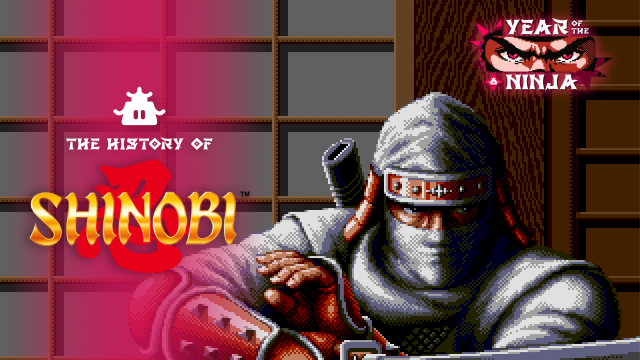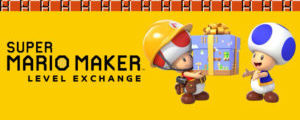In anticipation and celebration of this year’s release of Ninja Gaiden 2 Black, NINJA GAIDEN: Ragebound, SHINOBI: Art of Vengeance, and Ninja Gaiden 4, Nintendojo takes a look back at the history of this iconic genre, the games that defined it, and the new titles joining the pantheon in our special Year of the Ninja series.
Although long since eclipsed by Ninja Gaiden, SEGA’s Shinobi has the advantage of having a title literally synonymous with ninjas. Shinobi debuted in 1987 and has been running longer than Tecmo’s Ninja Gaiden (1988) or Capcom’s Strider (1989). Its 2D output is also more prolific than that of either of its rivals, and is – or at least was – distinct for having peculiar arcade-derived sensibilities.
Shinobi

In the same way that Ninja Gaiden’s NES titles proudly wear the influence of Castlevania, and Strider borrows from Ghosts n’ Goblins, the Shinobi series takes Namco’s Rolling Thunder as a starting point. Where 1986’s Rolling Thunder features a deadly secret agent ducking and jumping through a gauntlet of hooded goons, unloading a stream of bullets into them, 1987’s Shinobi features… also that, except that (some of) the bullets are shurikens. Of course, the ninja aesthetics are themselves a key differentiator, but Shinobi features a number of mechanical differences too. Ammo is unlimited, Rolling Thunder’s system of side doors is removed, the enemy variety is massively improved, and most infamously the protagonist, Joe Musashi, dies in a single hit.
Between Joe’s fragility, his infinite ammo, and the threatening mix of enemy types, Shinobi is a markedly more frantic game, and the player can very swiftly gain or lose ground. One quirk of the levels is that Joe doesn’t simply need to reach the end of each level, instead needing to rescue several children along the way. The children are essentially just item pickups, but saving them has two interesting properties, tied to the fact that each child saved remains saved even if Joe dies. One, each child has a dedicated “guard” enemy that will not respawn once the corresponding child is rescued, acting as a bit of a mercy mechanic for players having difficulty with a particular segment. Two, for more skilled players, when the player is able to rescue a couple of children without dying, their weak shuriken shots are replaced with more powerful pistol shots until they die, providing an incentive for skillful play, even for deep-pocketed players happy to insert coins over and over.
For most of its length, Shinobi is a surprisingly good time, albeit with one brutal late game caveat. As was common for arcade games, one credit buys you multiple lives, and you can occasionally earn extra lives via good play. When you die, whether you need to input a new credit or not, you restart your current stage segment, up until you reach the fifth and final stage. In the final stage, if you run out of lives and need to continue with a new credit… you simply cannot. It is game over. No matter how many coins you’ve pumped into the machine by that point, once you get a game over on the final stage, it is a true game over. It makes the endgame level design very difficult to learn. The good news is that the version on Switch, SEGA AGES Shinobi, has rewind and save state options and therefore makes learning this brutal final gauntlet feasible. Whether you ever graduate from those training wheels or not, the original Shinobi actually holds up well.
Shadow Dancer

There was only one arcade sequel to Shinobi, 1989’s Shadow Dancer. As the two year gap would suggest, Shadow Dancer is aesthetically more striking and features some new quirks. The protagonist now wears distinctive white robes and has a white dog, Yamato, as a companion. Yamato can help with enemy takedowns when the player performs a crouching attack while Yamato is barking. This does unfortunately mean that the player will often deploy Yamato accidentally. Even aside from Yamato’s overeagerness, Shadow Dancer is just a clunkier game than the original and is harder to recommend. It is not available on Switch.
Shadow Dancer: The Secret of Shinobi

A year after Shadow Dancer was released in arcades, a similarly named game was released for SEGA Genesis. It is not a port despite visual, conceptual, and gameplay similarities, with different levels, better handling, and a new method of dog-deployment (holding down the attack button) less prone to accidental usage. Like the original Shinobi, the Genesis version of Shadow Dancer is a tight and well-considered package. Unlike the original Shinobi, this Shadow Dancer does not have any sort of heartbreaking “you can no longer continue” mechanic kicking in at the home stretch. Instead it remains a worthy sequel throughout and is arguably the best of the purely arcade-style Shinobi games. Unfortunately, while it was previously available on Switch via SEGA Genesis Classics, that was delisted in late 2024.
Revenge of Shinobi

Between the release of Shinobi and Shadow Dancer, the Genesis debuted, and while SEGA has an impressive reputation and library at the arcade thanks to its System 16 library, it was less ready to take on Nintendo’s more console-friendly library at home. Seeking to build a true killer app for the Genesis, SEGA had a team retool the Shinobi concept in hopes of creating exactly that. Joe Musashi returns in this direct sequel to the arcade original, with an expanded moveset, various powerups and secrets hidden throughout the levels, and a greater emphasis on platforming.
The screen-clearing ninja magic of Shinobi has evolved into a toolkit of four spells. Ikazuchi shrouds Joe in an electric shield that absorbs a few hits, Karyu summons a fire dragon to heavily damage all enemies, Fushin gives Joe higher jumps which can enable new shortcuts, and Mijin is truly unique. It damages all enemies just like Karyu, and refills Joe’s health, but at the very high cost of one of Joe’s extra lives. It’s a lean but interesting list of spells, which allow the player to customize their play experience. Alternatively, they can avoid ever casting spells if they want to challenge themselves with a stricter “blades only” playstyle.

One distinctive feature of all the classic Shinobi games is a focus on ranged combat over melee combat, though melee combat is also part of the game. As in the arcade-style titles, Joe performs a melee attack only if a target is in melee range. Otherwise, he throws his kunai. His kunai are limited and the player needs to scrounge up ammunition. If Joe attacks while at the peak of a double jump, he will spend eight kunai at once to throw out a fan of kunai, as a sort of mini screen clearing attack with the added utility of allowing him to attack at angles he otherwise cannot. The eight kunai cost is not something that Joe can regularly afford, though, so careful consideration is required. This interacts with the POW powerup item, which boosts Joe’s kunai damage in addition to allowing him to block enemy projectiles, and which Joe loses when hit a single time. The POW item is hard to hold onto for a novice (unless they use Ikazuchi), but for an experienced player it allows them to use fans of kunai more often. It’s a clever system that evolves the player’s gameplay as they get better at the game.
Revenge of Shinobi also features a secret weapon: the inimitable Yuzo Koshiro providing the music. Some of the tracks here, including the title screen piece and the music for the first and sixth stages, are among the greatest on the system, and Koshiro’s fusion of more traditional compositions with dance music remains distinctive.
This all sounds like a rave review, but Revenge of Shinobi has some issues. The unifying principle behind the level design seems to have been “go **** yourself,” with a seemingly endless supply of enemies attacking from off screen, blind jumps into bottomless pits, and enemies attacking from off screen to send you into those bottomless pits. The controls feature high-commitment jumps, slow horizontal movement, and considerable knockback. None of that breaks some inviolable law of game design or anything – it just doesn’t feel very fun to play and learn. Every Shinobi game thus far has involved a lot of trial and error, but it is a less good fit for Revenge of Shinobi, which in retrospect can make it feel like a half-formed title between the more elegant Shinobi and Shadow Dancer on one side, and the more fully confident Shinobi III on the other. Revenge of Shinobi is available via Switch Online.
Odds & Ends

Between the releases of Revenge of Shinobi and Shinobi III came three other titles on SEGA’s lower end hardware. On the Master System, SEGA released The Cyber Shinobi, which is universally reviled as a poor product. On the Game Gear, however, SEGA released two portable titles, called Shinobi and Shinobi II: The Silent Fury in the west, but less confusingly titled The G.G. Shinobi and The G.G. Shinobi II: The Silent Fury in Japan. Both were again composed by Yuzo Koshiro, who turns in solid work even with the Game Gear’s inferior soundchip. Both titles also feature mechanics drawn from Revenge of Shinobi, but given the reduced screen real estate, they focus more on platforming gimmicks and Mega Man-style alternate weapon loadouts gained as the player completes the opening levels in any order. The first game’s final level is very long and very unpleasant; the second fares a little better in this regard, and is the one to try for the curious player. None of these are available on Switch, however.
Shinobi III: Return of the Ninja Master

Even though Revenge of Shinobi was received as the confident, show-stopping Genesis hit SEGA was hoping for, its team was not tasked with creating a sequel. As they went on to create another hit in Streets of Rage, that might have been the right call for SEGA, but could have left Shinobi in a lurch as SEGA eventually put another team, Megasoft, on the job. Megasoft only produced games under SEGA for all of one year before being merged into other teams, but somewhat improbably this was enough time for the team to make the definitive Shinobi game. Tastes vary when it comes to Shinobi games, with all of Shinobi, Shadow Dancer: The Secret of Shinobi, Revenge of Shinobi, Shinobi III, or the PS2 reboot getting the nod depending on who’s opining. But while Shinobi III clearly owes a large debt to Revenge of Shinobi, in particular, when later games wear the influence of Shinobi on their sleeves (e.g. Red’s Hagane: The Final Conflict, Joymasher’s Vengeful Guardian Moonrider, or Visco’s Ganryu II), it’s Shinobi III specifically that they’re looking to.
It’s no great surprise that a 1993 sequel would look better than its 1989 predecessor, even though Revenge of Shinobi was already a looker, but this understates just how good Shinobi III looks, especially on a CRT (or with a good CRT shader). Both the pixel work and the graphical effects are top notch here, among the best on the Genesis. While Yuzo Koshiro did not return to do the music, the three-person team replacing him rose to the challenge and continued Shinobi’s streak of killer soundtracks.

The single most substantial difference between the experience of Revenge of Shinobi vs Shinobi III is likely that while the latter remains challenging, it is less sadistic, with fewer blind deaths at the player’s expense. Fewer gunners positioned just offscreen to hilariously knock you into pit after pit. Just as important, though, is Joe’s revised moveset. His entire Revenge toolkit (including all four spells) returns, but he now also has a dash which can be chained into a katana hit with some invincibility frames, a TMNT-style dive kick, the ability to defend by holding attack, and a wall jump. All in all, this not only opens up the ability for more complex platforming with fail states other than “you died,” but it gives him superior lateral mobility and some new situational ways to approach fortified enemy positions. One interesting thing about holding attack to defend is that, if not preplanned, it requires that the player spends a kunai to initiate it, which is a moderately interesting tradeoff.
As with the arcade-style games and Revenge of Shinobi, in Shinobi III the ranged attack is the player’s default attack, which gives the classic series a distinctive vibe that would unfortunately start to fade away after Shinobi III. In fact, even the games mentioned above as being influenced by Shinobi III still moved away from the focus on kunai combat. Shinobi III began this transition not just by introducing the running slash and dive kick, but by allowing players with six button Genesis controllers to assign katana and kunai to different buttons for the first time. While this makes sense as a quality of life affordance, it does remove a level of design complexity present in making the katana a conditional melee range override on the kunai button. I’ve only ever played this game in the three button style (ninja magic, attack, jump) and that’s the version I can endorse, but as Shinobi III’s disciples show, a greater focus on deliberate melee attacks can work too. Like Revenge of Shinobi, Shinobi III is available on Switch Online, and I recommend it highly.
Shinobi Legions, Shinobi 3D, and the future

Shinobi III wasn’t the blockbuster success that Revenge of Shinobi was, as by 1993 the industry had moved on from the golden age of ninja games to a glut of mascot platformers and Street Fighter II wannabes, so perhaps it’s understandable that SEGA didn’t properly build a sequel. Frustratingly, this began SEGA’s era of shopping Shinobi around to one external developer after another, similar to Nintendo’s handling of Metroid following 2004’s Zero Mission, which involved passing what once seemed like one of Nintendo’s most precious jewels around from Retro to Team Ninja to MercurySteam and now back to Retro.
Of course, as Metroid demonstrates, an outside developer isn’t in and of itself bad, but for collaborators SEGA selected Tose (Japan’s famously workmanlike “ghost developer”) for Shinobi’s Saturn entry. At least, they are alleged to have selected Tose because the game’s credits do not actually credit any of the game’s developers (only the staff involved in the creation of the game’s badly dated FMV sequences). That itself is not indicative of a problem with the play experience of the game. Indeed, plenty about Shinobi Legions is pretty good, with a more technical moveset featuring such additions as a dedicated defend button and the ability to actively deflect projectiles back at attackers using sword strikes. While it doesn’t come together as gracefully as previous Shinobi titles, it’s honestly not bad, just disappointing as a sequel to Shinobi III. And while the mid-90s digitized models aren’t great and the FMVs are a curiosity at best, the soundtrack is once again a very solid piece of work.

After 16 years of 2D dormancy punctuated by two impressive 3D PS2 titles (Shinobi and Nightshade), SEGA brought Shinobi back for one more romp, this one an early 3DS game by mobile game developer Griptonite, which was known for the kind of licensed games that didn’t have to be good to be successful, and which was absorbed by Glu Mobile the same year that Shinobi 3D came out. It would be fortunate if lightning struck twice and Griptonite had, like Megasoft, managed to make one truly great game before being absorbed. Unfortunately, Shinobi 3D really is just about adequate, a little better than par for Griptonite but more than a little underwhelming for Shinobi. Most disappointingly, Shinobi 3D more or less fully transitions the game from being kunai-focused to being katana-focused, but most bafflingly, Shinobi 3D’s graphics feature a constantly distracting and garish barrage of giant and cheap looking point values popping out of every struck enemy.
Unsurprisingly, neither Shinobi Legions nor Shinobi 3D are available on Switch.
Looking ahead to the new SHINOBI: Art of Vengeance (not released as of this writing), it does at least look like the game is in talented hands (Lizardcube of Streets of Rage 4 fame and accolades). Various nods to series iconography and conventions will be included, even if the game design does not resemble any previous Shinobi game particularly closely, based on the demo. No one-hit kills for Joe or most enemies, a focus on sword combos, enemies with enough health that juggling is a reasonable tactic, etc. Here’s hoping that it’s a great game and that this can be, like Revenge of Shinobi, the dawn of a new golden age for the series, even if it isn’t a continuation of Shinobi III’s impeccable design.
FURTHER READING & VIEWING
- SEGA-16 article on the creation of Revenge of Shinobi
- Translated interview with Noriyoshi Ohba, lead on Revenge of Shinobi
- Short documentary on the making of Revenge of Shinobi, Streets of Rage, and Shinobi III
- Translated interview with Tomoyuki Ito, lead on Shinobi III
Please enjoy these other gaming history features:




 ShareThis
ShareThis






